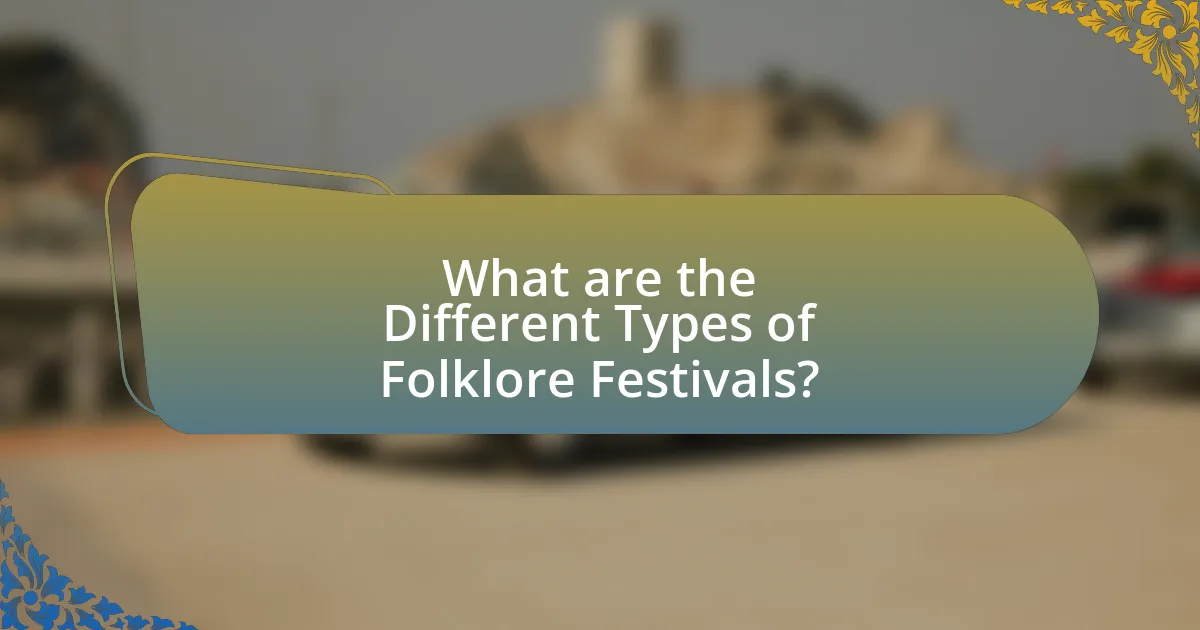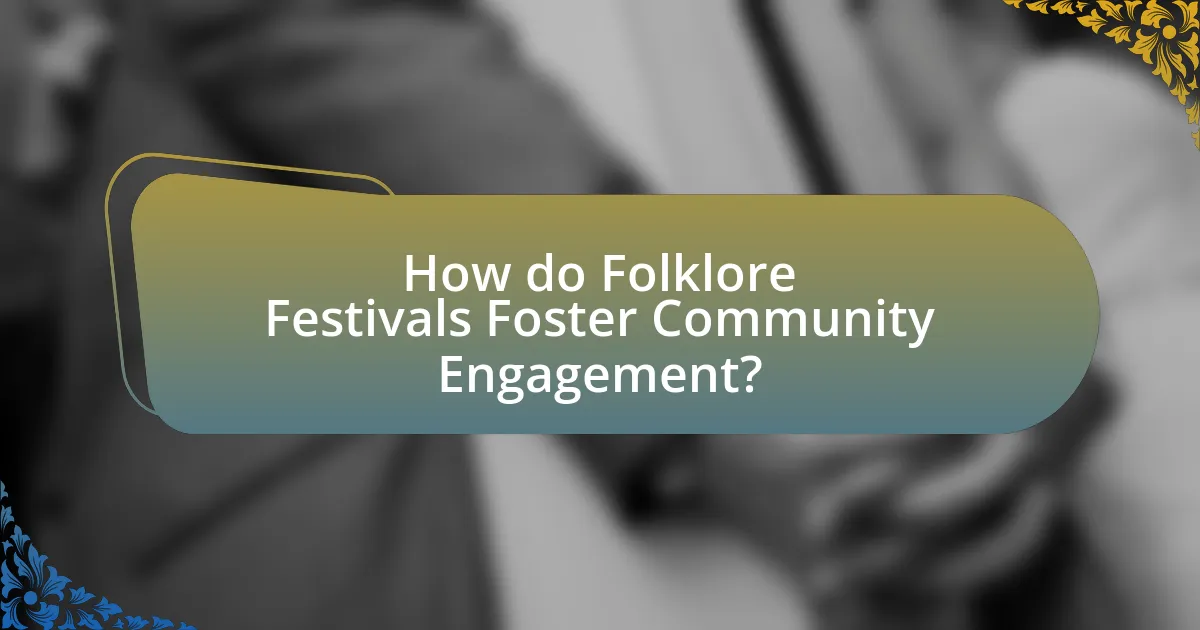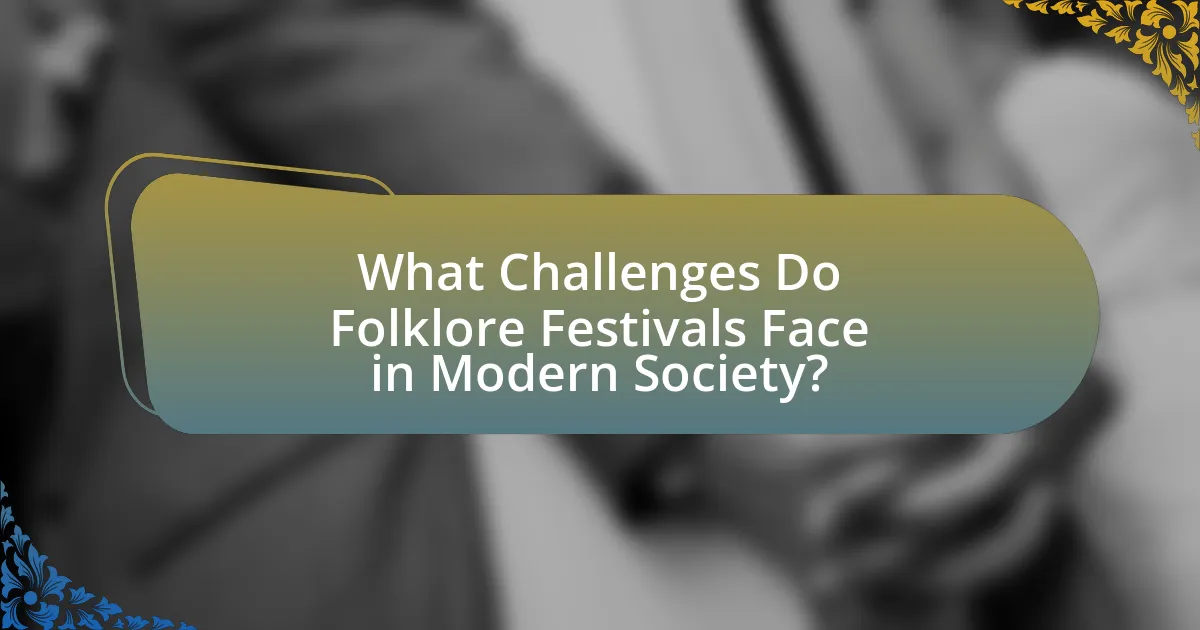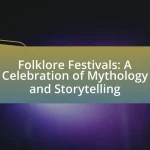Folklore festivals are cultural events that celebrate traditional practices, music, dance, crafts, and stories, playing a crucial role in preserving cultural heritage. These festivals facilitate the transmission of cultural knowledge across generations, reinforce community identity, and promote cultural diversity. The article explores how folklore festivals contribute to cultural identity, showcase various cultural elements, reflect community history, and engage younger generations in traditional practices. It also addresses the challenges these festivals face in modern society, including globalization and commercialization, while highlighting best practices for organizing successful events that foster community involvement and sustainability.

What are Folklore Festivals and Their Significance in Cultural Heritage?
Folklore festivals are cultural events that celebrate and showcase traditional practices, music, dance, crafts, and stories of a community or region. These festivals play a significant role in preserving cultural heritage by providing a platform for the transmission of cultural knowledge and practices across generations. For instance, UNESCO recognizes the importance of such festivals in maintaining intangible cultural heritage, as they foster community identity and continuity. By engaging participants and audiences in traditional customs, folklore festivals help to reinforce social bonds and promote cultural diversity, ensuring that unique cultural expressions are not lost over time.
How do Folklore Festivals contribute to cultural identity?
Folklore festivals contribute to cultural identity by serving as platforms for the expression and preservation of traditional customs, practices, and narratives. These festivals showcase local art forms, music, dance, and cuisine, which are integral to a community’s heritage. For instance, the annual National Folk Festival in the United States highlights diverse cultural expressions from various ethnic groups, reinforcing their unique identities while fostering a sense of belonging among participants and attendees. By facilitating intergenerational transmission of cultural knowledge, folklore festivals help maintain and revitalize traditions that might otherwise fade, thus solidifying cultural identity within communities.
What elements of culture are showcased during Folklore Festivals?
Folklore festivals showcase various elements of culture, including traditional music, dance, crafts, storytelling, and culinary practices. These festivals serve as platforms for communities to express their unique cultural identities and heritage. For instance, traditional music and dance performances often reflect historical narratives and social values, while crafts highlight local artistry and techniques passed down through generations. Additionally, storytelling sessions preserve oral traditions, and culinary offerings represent regional flavors and cooking methods, reinforcing the connection between culture and community.
How do these festivals reflect the history of a community?
Festivals reflect the history of a community by serving as a living archive of its traditions, values, and collective experiences. These events often commemorate significant historical events, celebrate cultural milestones, and showcase traditional practices that have been passed down through generations. For instance, the annual Oktoberfest in Munich not only highlights Bavarian culture but also traces its origins back to a royal wedding in 1810, illustrating how historical events shape contemporary celebrations. Additionally, festivals often incorporate local folklore, music, and cuisine, which further reinforces the community’s identity and heritage. This connection to history fosters a sense of belonging and continuity among community members, ensuring that their cultural narratives are preserved and transmitted to future generations.
Why are Folklore Festivals important for cultural preservation?
Folklore festivals are important for cultural preservation because they serve as platforms for showcasing and transmitting traditional practices, stories, and art forms. These festivals facilitate intergenerational knowledge transfer, allowing younger generations to engage with and learn about their cultural heritage. For instance, UNESCO recognizes the role of such festivals in promoting intangible cultural heritage, highlighting that they help maintain community identity and cohesion. By celebrating local customs, folklore festivals not only preserve unique cultural expressions but also foster appreciation and respect for diverse traditions, ensuring their survival in a rapidly globalizing world.
What role do these festivals play in passing down traditions?
Folklore festivals play a crucial role in passing down traditions by serving as platforms for cultural expression and community engagement. These festivals facilitate the transmission of oral histories, traditional music, dance, and crafts, ensuring that cultural practices are actively practiced and celebrated across generations. For instance, events like the National Folk Festival in the United States showcase diverse cultural heritages, allowing participants to learn and participate in traditional activities, thereby reinforcing their cultural identity. This intergenerational exchange is vital for maintaining the continuity of cultural heritage, as evidenced by studies that highlight the role of community festivals in fostering cultural pride and awareness among younger generations.
How do Folklore Festivals engage younger generations in cultural practices?
Folklore festivals engage younger generations in cultural practices by providing interactive experiences that promote participation in traditional arts, music, and storytelling. These festivals often include workshops, performances, and hands-on activities that allow youth to learn and practice cultural traditions directly. For instance, a study by the National Endowment for the Arts found that participation in cultural events increases cultural awareness and appreciation among young attendees, fostering a sense of identity and community. Additionally, folklore festivals often utilize social media and digital platforms to attract younger audiences, making cultural practices more accessible and relevant to their lives.

What are the Different Types of Folklore Festivals?
Folklore festivals can be categorized into several types, including traditional, seasonal, and thematic festivals. Traditional folklore festivals celebrate the cultural heritage of a specific community, often featuring music, dance, and storytelling that reflect local customs and history. Seasonal festivals, such as harvest or solstice celebrations, mark significant times of the year and often include rituals and activities tied to agricultural cycles. Thematic festivals focus on specific aspects of culture, such as crafts, food, or historical events, showcasing the diversity of folklore through specialized programming. These classifications highlight the various ways folklore festivals contribute to the preservation and promotion of cultural heritage.
How do regional variations influence Folklore Festivals?
Regional variations significantly influence Folklore Festivals by shaping the themes, performances, and traditions showcased at these events. Each region’s unique cultural heritage, including local myths, music, dance, and crafts, directly informs the festival’s content, creating a distinct identity that reflects the community’s history and values. For instance, the Albuquerque International Balloon Fiesta in New Mexico incorporates Native American cultural elements, while the Quebec Winter Carnival highlights French-Canadian traditions. These variations not only enhance the authenticity of the festivals but also promote cultural exchange and understanding among diverse communities, thereby reinforcing the role of folklore festivals in preserving and celebrating cultural heritage.
What are some examples of unique Folklore Festivals around the world?
Some examples of unique Folklore Festivals around the world include the Harbin International Ice and Snow Sculpture Festival in China, the Day of the Dead in Mexico, and the Up Helly Aa Fire Festival in Scotland. The Harbin festival, held annually since 1963, showcases intricate ice sculptures and attracts millions of visitors, highlighting the region’s winter culture. The Day of the Dead, celebrated on November 1st and 2nd, honors deceased loved ones with vibrant altars and festivities, reflecting Mexico’s rich traditions and beliefs about death. Up Helly Aa, celebrated in January, features a Viking-themed procession and the burning of a longship, commemorating the Norse heritage of the Shetland Islands. These festivals serve as vital expressions of cultural identity and heritage preservation.
How do themes and activities differ among various Folklore Festivals?
Themes and activities at folklore festivals vary significantly based on regional traditions, cultural heritage, and historical context. For instance, the Albuquerque International Balloon Fiesta in New Mexico emphasizes hot air ballooning as a cultural spectacle, while the National Folk Festival in the United States showcases diverse music and dance forms, reflecting the multicultural fabric of American society. Additionally, the Festival of Folklore in Italy focuses on traditional crafts and culinary arts, highlighting local artisans and regional cuisine. These differences illustrate how each festival aims to celebrate and preserve unique cultural identities, thereby reinforcing community ties and promoting cultural education.
What are the common features of Folklore Festivals?
Folklore festivals commonly feature traditional music, dance, crafts, and storytelling that reflect the cultural heritage of a community. These festivals serve as platforms for showcasing local customs and practices, often including performances by folk artists and artisans who demonstrate their skills. Additionally, folklore festivals typically involve communal activities, such as food sharing and workshops, which foster community engagement and participation. The presence of historical reenactments or parades further enhances the cultural experience, allowing attendees to connect with their heritage in a tangible way.
What types of performances are typically featured?
Folklore festivals typically feature traditional music, dance, storytelling, and craft demonstrations. These performances showcase the cultural heritage of specific communities, often highlighting regional styles and historical narratives. For instance, traditional folk dances may include specific regional steps and costumes, while storytelling often involves local legends and myths that have been passed down through generations. Such performances are essential for cultural preservation, as they engage audiences and foster appreciation for diverse cultural expressions.
How do crafts and food play a role in these festivals?
Crafts and food are integral to folklore festivals as they embody and showcase cultural heritage. Crafts, such as traditional weaving, pottery, and woodworking, serve as tangible representations of a community’s history and artistic expression, often passed down through generations. Food, including regional dishes and traditional recipes, reflects local agricultural practices and culinary customs, fostering a sense of identity and belonging among participants. For instance, the preparation and sharing of traditional meals during festivals not only celebrate cultural diversity but also promote social cohesion and community bonding. These elements work together to preserve and transmit cultural values, ensuring that future generations maintain a connection to their heritage.

How do Folklore Festivals Foster Community Engagement?
Folklore festivals foster community engagement by providing a platform for local traditions, arts, and cultural expressions to be shared and celebrated. These events encourage participation from community members, allowing them to showcase their heritage through performances, crafts, and storytelling. For instance, a study by the National Endowment for the Arts found that community festivals enhance social cohesion by bringing diverse groups together, promoting interaction and collaboration among residents. Additionally, folklore festivals often involve local businesses and artisans, which strengthens economic ties and fosters a sense of pride in the community’s cultural identity.
What impact do Folklore Festivals have on local economies?
Folklore festivals significantly boost local economies by attracting tourists and generating revenue. These events create jobs in hospitality, retail, and entertainment sectors, leading to increased spending in the community. For instance, a study by the National Endowment for the Arts found that cultural festivals can generate millions in economic impact, with some events reporting a return of $4 for every $1 spent by visitors. Additionally, local artisans and vendors benefit from increased sales opportunities, further stimulating economic growth.
How do these festivals promote tourism and local businesses?
Folklore festivals promote tourism and local businesses by attracting visitors who contribute to the local economy through spending on accommodations, food, and souvenirs. For instance, a study by the National Endowment for the Arts found that cultural events can increase local tourism by up to 30%, leading to higher revenues for local businesses. Additionally, these festivals often showcase local artisans and vendors, providing them with a platform to sell their products, which further stimulates economic activity in the area.
What community initiatives are often associated with Folklore Festivals?
Community initiatives often associated with folklore festivals include cultural workshops, local artisan markets, and educational programs. These initiatives aim to engage the community in preserving and promoting traditional arts, crafts, and performances. For example, workshops may teach traditional dance or music, while artisan markets provide a platform for local craftspeople to showcase their work, thereby fostering economic support for cultural heritage. Educational programs often involve schools and local organizations, emphasizing the importance of cultural history and practices, which helps to instill a sense of pride and continuity within the community.
How do Folklore Festivals encourage intercultural dialogue?
Folklore festivals encourage intercultural dialogue by providing a platform for diverse cultural expressions and interactions among participants from various backgrounds. These festivals showcase traditional music, dance, crafts, and culinary arts, allowing attendees to experience and appreciate different cultural heritages firsthand. For instance, the International Folklore Festival in Neuchâtel, Switzerland, features performances from over 30 countries, fostering understanding and respect among cultures. Additionally, workshops and discussions at these events promote direct communication and collaboration, further enhancing mutual respect and cultural exchange.
What opportunities do these festivals create for cultural exchange?
Folklore festivals create significant opportunities for cultural exchange by bringing together diverse communities to share traditions, art, and practices. These events facilitate interactions among participants from different cultural backgrounds, allowing for the exchange of ideas, customs, and artistic expressions. For instance, festivals often feature performances, workshops, and exhibitions that showcase various cultural heritages, fostering mutual understanding and appreciation. Research indicates that such gatherings can enhance social cohesion and promote intercultural dialogue, as evidenced by the success of events like the Smithsonian Folklife Festival, which highlights cultural diversity and encourages collaboration among artists from around the world.
How can Folklore Festivals help bridge cultural divides?
Folklore festivals can bridge cultural divides by promoting understanding and appreciation of diverse cultural traditions. These festivals showcase various cultural expressions, such as music, dance, art, and storytelling, allowing participants from different backgrounds to engage with and learn about each other’s heritage. For instance, the Smithsonian Folklife Festival in the United States has successfully highlighted the cultural practices of various communities, fostering dialogue and collaboration among attendees. By creating a shared space for cultural exchange, folklore festivals facilitate connections that transcend cultural barriers, ultimately contributing to social cohesion and mutual respect among diverse populations.

What Challenges Do Folklore Festivals Face in Modern Society?
Folklore festivals face several challenges in modern society, including declining participation, commercialization, and cultural dilution. Declining participation is evident as younger generations show less interest in traditional practices, leading to reduced audience numbers and engagement. Commercialization poses a threat as festivals often prioritize profit over authentic cultural representation, resulting in a shift from genuine folklore to entertainment-focused events. Cultural dilution occurs when traditional elements are altered or simplified to appeal to broader audiences, risking the loss of cultural significance. These challenges highlight the need for folklore festivals to adapt while maintaining their core mission of preserving cultural heritage.
How is globalization affecting the authenticity of Folklore Festivals?
Globalization is diminishing the authenticity of folklore festivals by introducing homogenized cultural elements that overshadow traditional practices. As global influences permeate local cultures, festivals increasingly incorporate commercialized and standardized performances, often prioritizing entertainment value over genuine cultural expression. For instance, research by the United Nations Educational, Scientific and Cultural Organization (UNESCO) highlights that many festivals now feature international acts and modern interpretations that dilute original cultural narratives, leading to a loss of unique local identities. This trend is evident in various regions where traditional music and dance forms are replaced or altered to appeal to broader audiences, thereby compromising the festivals’ roles as authentic representations of cultural heritage.
What measures can be taken to preserve traditional practices?
To preserve traditional practices, organizing folklore festivals is essential as they provide a platform for showcasing cultural heritage. These festivals facilitate the transmission of knowledge and skills through workshops, performances, and storytelling, engaging both participants and audiences. Research indicates that such events can increase community involvement and awareness, thereby reinforcing cultural identity. For instance, the National Folk Festival in the United States has successfully highlighted various traditional arts, ensuring their continuity and appreciation among younger generations.
How do festivals adapt to contemporary cultural trends?
Festivals adapt to contemporary cultural trends by incorporating modern themes, technologies, and diverse cultural expressions into their programming. For instance, many festivals now feature digital art installations, social media engagement, and interactive experiences that resonate with younger audiences. This adaptation is evident in events like the Coachella Valley Music and Arts Festival, which blends traditional music with contemporary genres and utilizes social media for promotion and audience interaction. Additionally, festivals increasingly focus on inclusivity and representation, showcasing a wider array of cultural backgrounds and contemporary issues, thereby reflecting the evolving societal values and interests.
What are the environmental impacts of Folklore Festivals?
Folklore festivals can have significant environmental impacts, including increased waste generation, resource consumption, and potential habitat disruption. These events often attract large crowds, leading to litter and pollution, which can harm local ecosystems. For instance, a study by the University of California found that festivals can produce up to 1,000 pounds of waste per 1,000 attendees, highlighting the need for effective waste management strategies. Additionally, the infrastructure required for such festivals, such as temporary stages and facilities, can lead to land degradation and disturbance of wildlife habitats.
How can festivals promote sustainability in their practices?
Festivals can promote sustainability in their practices by implementing waste reduction strategies, utilizing renewable energy sources, and encouraging local sourcing of materials and food. For instance, many festivals adopt zero-waste policies, which aim to divert at least 90% of waste from landfills through recycling and composting initiatives. Additionally, festivals can power their events using solar panels or wind energy, significantly reducing their carbon footprint. Research indicates that local sourcing not only supports regional economies but also minimizes transportation emissions, as seen in the 2019 Green Festival in San Francisco, which featured over 80% local vendors. These practices collectively contribute to a more sustainable event model while preserving cultural heritage through community engagement and responsible resource management.
What are some examples of eco-friendly initiatives at Folklore Festivals?
Eco-friendly initiatives at folklore festivals include waste reduction programs, the use of renewable energy sources, and promoting local and sustainable food options. For instance, many festivals implement recycling and composting stations to minimize waste, which has been shown to significantly reduce landfill contributions. Additionally, some festivals utilize solar panels or wind turbines to power their events, demonstrating a commitment to renewable energy. Furthermore, by featuring local farmers and artisans, these festivals support sustainable agriculture and reduce carbon footprints associated with food transportation.
What are best practices for organizing successful Folklore Festivals?
Best practices for organizing successful Folklore Festivals include thorough planning, community involvement, and effective marketing strategies. Thorough planning involves setting clear objectives, budgeting appropriately, and securing necessary permits and venues. Community involvement is crucial, as engaging local artists, performers, and cultural groups fosters authenticity and enhances participation. Effective marketing strategies, such as utilizing social media, local media partnerships, and targeted outreach, ensure wider visibility and attendance. According to a study by the National Endowment for the Arts, festivals that actively involve the community see a 30% increase in attendance and participant satisfaction, highlighting the importance of these practices in achieving success.
How can organizers ensure community involvement and support?
Organizers can ensure community involvement and support by actively engaging local residents in the planning and execution of folklore festivals. This can be achieved through community meetings, surveys, and collaboration with local cultural groups, which fosters a sense of ownership and investment in the event. Research indicates that festivals that incorporate local traditions and involve community members in decision-making processes see higher attendance and participation rates, as evidenced by the 2019 study published in the Journal of Cultural Heritage Management, which found that 75% of participants felt more connected to their community when involved in local cultural events.
What strategies can be employed to enhance visitor experience?
To enhance visitor experience at folklore festivals, organizers can implement interactive workshops, cultural performances, and guided tours. Interactive workshops allow visitors to engage directly with traditional crafts and practices, fostering a deeper connection to the culture. Cultural performances, such as music and dance, provide entertainment while showcasing the heritage, making the experience memorable. Guided tours can offer insights into the history and significance of the festival, enriching visitors’ understanding. Research indicates that festivals incorporating these strategies see increased visitor satisfaction and engagement, as evidenced by a study published in the Journal of Cultural Heritage Management and Sustainable Development, which found that interactive elements significantly boost visitor enjoyment and learning.














